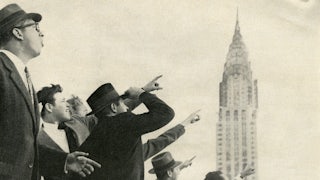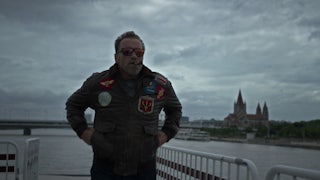In Robert Zemeckis’s 1997 film Contact, Dr. Ellie Arroway (Jodie Foster) discovers an alien signal, analyzes it, cracks its code, deciphers a blueprint for a gigantic space travel machine, convinces the federal government to build that machine at great cost, gets bumped from captaining its first flight because she doesn’t believe in God, avoids dying in the terrorist attack that prevents that first flight, gets to be captain of the second identical space travel machine built in secret by a weirdo gazillionaire, travels successfully through a galaxy-wide network of wormholes, arrives at some unknown beachfront location in distant space, and when she gets out of the ship, what unimaginable alien being does she meet? Turns out it’s her dad.
Just as in Carl Sagan’s 1985 novel, Contact, she never gets to see what these alien beings look like. The aliens, it seems, are very concerned about not blowing our tiny human brains too hard and have produced a scenario in which Ellie is able to hear transformative truths about the nature of the universe through the comforting mouthpiece of her late, beloved father. Ellie is not disappointed; indeed, she’s deeply moved. This event of world-historical importance thus plays out through a moment of familial intimacy, the possibility of extraterrestrial life expressed through a father’s love. Ellie, for one moment in this whole shaggy dog story of first contact, is not alone.

I remember being considerably less excited about seeing Ellie’s dad than Ellie was when I saw Contact in high school. I wanted to see a big, honking, slimy, giant-brained, gelatinous alien, not acclaimed character actor David Morse. Likewise, I recall being similarly disappointed when Jessica Chastain unravels the mysteries of the universe in Christopher Nolan’s own visually arresting wormhole epic Interstellar, only to realize that the unseen intelligence transmitting messages to her was also, if you can believe it, her long lost father Matthew McConaughey. Are there any aliens out there who don’t look like our dads? My kingdom for a xenomorph!
These alien switcheroos are no accident. In fact, both Contact and Interstellar follow Sagan’s famous rule that we should never see an alien, that our measly human imaginations could only understate the strangeness of alien life by trying to visualize it. Pop culture is certainly full of films and novels and TV series that gleefully break this rule, but some of the best aliens are the ones we only catch glimpses of, who exist only partially, only in darkness, only in fleeting, frightening peeks.
“A truly alien alien is so incomprehensible that stories about them just become stories about human beings,” Jaime Green writes in her new book, The Possibility of Life: Science, Imagination, and Our Quest for Kinship in the Universe. In a series of chapters focused on everything from the origins of the universe to the speculative scene of first contact, Green writes about imaginary microbes and massive extraterrestrial engineering experiments and tentacled squid people and radio signals from distant, unknown origins. But her main characters are sci-fi writers and scientists whose lives are and have been dedicated to dreaming of and seeking out life beyond our home planet. We are, for better and worse, stuck within the worlds we have imagined and built here, unable to see beyond ourselves in ways both petty and profound. The Possibility of Life is not a book about aliens; it’s about human beings and the possibilities of our lives, together and alone.
Green is drawn to aliens because they represent the point at which science and ordinary human imagination meet. For Green, the most interesting question to ask about aliens isn’t where or whether or not but what if? This question is at the heart of scientific inquiry just as much as it’s at the heart of our dreams and nightmares. Because of that, the search for aliens in outer space is, at the same time, a tour through alien stories, from classic fictions like Sagan’s to the more contemporary envisionings of Ted Chiang and Nnedi Okorafor. In her telling, novels, short stories, films, and TV shows about extraterrestrials resemble folktales: They give us myths and archetypes that explain an unexplainable world to the people who live in it.
One of my favorite things about The Possibility of Life, for instance, is how seriously it takes Star Trek. The book’s first chapter begins with an extended reading of an episode from The Next Generation. In it, the crew of the Enterprise races against a team of Romulans and a team of Cardassians to find a bit of DNA that seems to encode a massive galactic mystery. What they eventually find, though, is a story. An ancient, humanoid hologram pops up to tell them that they were the very first intelligent life-forms to evolve anywhere. They searched and searched for others but found “none like ourselves,” an empty universe. So, instead of collapsing in despair, they seeded the stars with their own DNA, making way for dozens of different species—the very humanoid folks bopping around in this episode—to eventually emerge in their image.
Some of the searchers are disappointed, and some are moved. For Green, this episode is a story about the fear of a lonely universe, but it’s also a story about hope. It’s about the idea that there is possible kinship everywhere you look, even when you look inward. As Picard says, “an individual was a community of individuals. Inside us are many voices, each with its own desires, its own style, its own view of the world.” There’s a lot we don’t understand, even about the things we can see, and that lack of knowledge can feel isolating, even scary. Aliens, even scary ones, help with that.
In keeping with that opening tale, a big part of The Possibility of Life is about how alien even our own world is to us. Green is adept at stripping away the layers of anthropomorphism and cliché that render our often strange Earth familiar to us. One of the common problems Green describes, for instance, is the problem of imagining extraterrestrial life that isn’t, essentially, humanoid. Just like Sagan and Nolan, both scientists and sci-fi artists often produce aliens that look a lot like us, whether they resemble our dads or even just walk on two feet or see through eyes on faces. To be fair, Green cites a number of experts speculating that, given how difficult it is for life to evolve, it’s entirely possible that if we ever do meet life on other planets, they will look a lot like us. Our adaptations, in other words, might represent broadly applicable solutions to problems all life, anywhere, has to solve. But not everyone agrees, and, plenty of other experts suggest that life elsewhere might be so different, so fundamentally alien, as to be unrecognizable to us as life. Surprisingly, a pretty big question amongst scientists searching for life on other planets is what life even means. Would we know it when we saw it?
Some of the most fascinating and affecting moments in Green’s book are when she examines animals and experiences readily available in our own lives that might provide a model for what extraterrestrial life might look or feel like. Consider the dolphin. Dolphins, it turns out, are really weird. We think about them, often, as intelligent fishy mammals who do tricks and make cool noises and are easy to embroider on vacation sweatshirts. But our default understanding of dolphins as close intellectual peers to us in the animal kingdom belies how differently intelligent they are, or rather, how unlike ours their minds work. Dolphins, as Green notes, are highly evolved, but their evolution separated from our species’ evolution nearly a hundred million years ago. In all that time on their own evolutionary path, dolphins’ smarts developed in ways it’s hard for us to even imagine. That lack of imagination, according to scientists like Jason Bruck—an expert in dolphin communication—can prevent us from asking the right questions that will lead us to the right answers about how dolphins’ minds work.
Dolphins, for instance, can recognize each other by tasting urine. Once you think about it—the watery world they swim in—it makes sense, but for humans, urine is not the most intuitive social medium. As Green suggests, though, the key to even possibly encountering this discovery lay in Bruck’s ability to think outside the human, to imagine something genuinely different and alien in a common seafaring mammal. “I can figure out the dolphins are tasting each others’ pee and getting social information from that,” Bruck told Green, “because I’m not thinking of them like people with fins.” If even research into Flipper can be stymied by the impulse to anthropomorphize, how much might it impact research into potential extraterrestrial neighbors? Why would we assume that, if we ever found these mysterious beings, that we’d recognize them?
Green’s most important insight in The Possibility of Life is not, however, that when we embark on our Quixotic search through the cosmos, we’re really searching for ourselves. What she most uniquely apprehends is why.
The discoveries of Copernicus and Galileo—that showed the Earth was not at the center of the universe and told of planets beyond ours—might seem to have been discoveries of plenty and potential. Perhaps at first these revelations opened up the skies, but, as technology improved, they also hollowed them out. “Then we learned the details,” she writes, “the airless worlds, the baking atmosphere, the stars flinging sterilizing rays at all their planets. As our telescopes got better, and our rovers got on their rockets, we learned the lonelier truth.”
This “lonelier truth” is ultimately what the scientists and fantasists Green profiles are seeking to unfold or even debunk. There’s the astronomer Steven J. Dick who tells us “there is no such thing as immediate discovery,” that, in other words, given the distances involved, the time scale of the discovery of alien life will be vastly different than the time scale of an individual human life. Or there’s Jason Wright, an optimistic researcher nevertheless haunted by the idea that, even if we got a real alien signal, we wouldn’t know what to do with it. “He likened it,” Green writes, “to giving Thomas Edison a modern cable modem and seeing if he could access all the information on the internet.” These stories are filled with triumphant and tragic figures whose lives are inextricably tied to the impossible possibility of other lives existing beyond our own. In Green’s empathetic telling, the search for aliens or Dyson spheres or drinkable water on distant planets is, at tremendous scale, a fight against loneliness.
Green herself is a searcher too. Every page of this book pirouettes elegantly between marvel and melancholy. Green wonders if “every inhabited planet has its one lonely species”; she believes that “we hope for an inhabited cosmos because the alternative feels too lonely.” She relates Carl Sagan’s hope that the famous “Pale Blue Dot” photograph would make Earthlings feel, not united, but alone, solely responsible for our own fates. Sci-fi novels famously can encompass thousands of years of narrative, generations of successive protagonists, and many of even the most hopeful of Green’s subjects know their research might well not yield tangible, eureka-style results in their lifetimes. We live on the Pale Blue Dot, but we are also, all of us, little dots on our own, worlds strange and alien and unknowable to the people around us.
But to be obsessed, abducted, overtaken by this idea that life exists elsewhere is to find a particular form of community, even a particular vision of a future for an imperiled Earth. And Green’s book understands that deeply. Our imagination of what an inhabited universe might look like is at turns transcendent and scary, but so too is intimacy with other people at all. The Possibility of Life is a clear, clean, unsparing signal from a writer of rare communicative power that, even if we are alone in the cosmos, so is everyone else. So we keep looking together, keep hoping together, having conversations with friends who might never answer back, might not be there at all.






